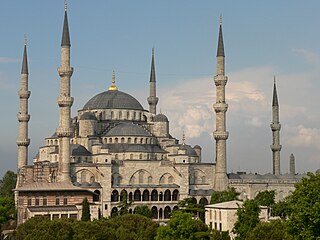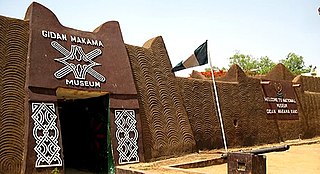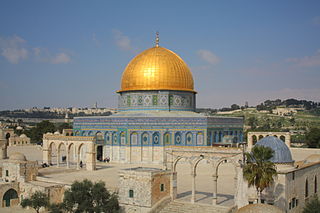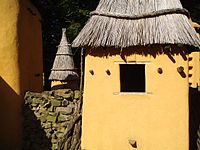
Islamic architecture comprises the architectural styles of buildings associated with Islam. It encompasses both secular and religious styles from the early history of Islam to the present day. The Islamic world encompasses a wide geographic area historically ranging from western Africa and Europe to eastern Asia. Certain commonalities are shared by Islamic architectural styles across all these regions, but over time different regions developed their own styles according to local materials and techniques, local dynasties and patrons, different regional centers of artistic production, and sometimes different religious affiliations.

The Blue Mosque in Istanbul, also known by its official name, the Sultan Ahmed Mosque, is an Ottoman-era historical imperial mosque located in Istanbul, Turkey. It was constructed between 1609 and 1617 during the rule of Ahmed I and remains a functioning mosque today. It also attracts a large number of tourists and is one of the most iconic and popular monuments of Ottoman architecture.

Kano is a city in northern Nigeria and the capital of Kano State. It is the second largest city in Nigeria after Lagos, with over ten million citizens living within 449 km2 (173 sq mi). Located in the Savanna, south of the Sahel, Kano is a major route of the trans-Saharan trade, having been a trade and human settlement for millennia. It is the traditional state of the Dabo dynasty who have ruled as emirs over the city-state since the 19th century. Kano Emirate Council is the current traditional institution inside the city boundaries of Kano, and under the authority of the Government of Kano State.

Katsina, likely from "Tamashek" or mazza (men) with "inna" (mother) is a Local Government Area and the capital city of Katsina State, in northern Nigeria.

Sudano-Sahelian architecture refers to a range of similar indigenous architectural styles common to the African peoples of the Sahel and Sudanian grassland (geographical) regions of West Africa, south of the Sahara, but north of the fertile forest regions of the coast.

Ottoman architecture is an architectural style or tradition that developed under the Ottoman Empire over a long period, undergoing some significant changes during its history. It first emerged in northwestern Anatolia in the late 13th century and developed from earlier Seljuk Turkish architecture, with influences from Byzantine and Iranian architecture along with other architectural traditions in the Middle East. Early Ottoman architecture experimented with multiple building types over the course of the 13th to 15th centuries, progressively evolving into the classical Ottoman style of the 16th and 17th centuries. This style was a mixture of native Turkish tradition and influences from the Hagia Sophia, resulting in monumental mosque buildings focused around a high central dome with a varying number of semi-domes. The most important architect of the classical period is Mimar Sinan, whose major works include the Şehzade Mosque, Süleymaniye Mosque, and Selimiye Mosque. The second half of the 16th century also saw the apogee of certain decorative arts, most notably in the use of Iznik tiles.

Hausa Kingdoms, also known as Hausa Kingdom or Hausaland, was a collection of states started by the Hausa people, situated between the Niger River and Lake Chad. Hausaland lay between the Western Sudanic kingdoms of Ancient Ghana, Mali and Songhai and the Eastern Sudanic kingdoms of Kanem-Bornu. Hausaland took shape as a political and cultural region during the first millennium CE as a result of the westward expansion of Hausa peoples. They arrived to Hausaland when the terrain was converting from woodlands to savannah. They started cultivating grains, which led to a denser peasant population. They had a common language, laws and customs. The Hausa were known for fishing, hunting, agriculture, salt-mining, and blacksmithing.

Moorish architecture is a style within Islamic architecture which developed in the western Islamic world, including al-Andalus and what is now Morocco, Algeria, and Tunisia. Scholarly references on Islamic architecture often refer to this architectural tradition in terms such as architecture of the Islamic West or architecture of the Western Islamic lands. The use of the term "Moorish" comes from the historical Western European designation of the Muslim inhabitants of these regions as "Moors". Some references on Islamic art and architecture consider this term to be outdated or contested.

The Hausa are a native ethnic group in West Africa. They speak the Hausa language, which is the second most spoken language after Arabic in the Afro-Asiatic language family. The Hausa are a culturally homogeneous people based primarily in the Sahelian and the sparse savanna areas of southern Niger and northern Nigeria respectively, numbering around 86 million people, with significant populations in Benin, Cameroon, Ivory Coast, Chad, Central African Republic, Togo, Ghana, as well as smaller populations in Sudan, Eritrea, Equatorial Guinea, Gabon, Senegal and the Gambia.

The Great Mosque of Tlemcen is a major historic mosque in Tlemcen, Algeria. It was founded and first built in 1082 but modified and embellished several times afterwards. It is considered one of the most important examples of architecture under the Almoravid dynasty.

Gidan Makama Museum Kano or Kano Museum is a museum in Kano, Nigeria. This building served as temporary palace of Sarakunan Hausa of Kano before the current palace Gidan Rumfa was constructed in the 15th century The museum has a significant collections of arts, crafts and items of historic interest related to the Kano area. Located in a 15th-century historical building, which is recognised as a National Monument by the Government of Nigeria. The museum is divided into 11 galleries, each with their own centre of focus. Galleries include the Zaure or the main entrance hall with displays of traditional materials, city walls and maps of Kano, the history of statehood, Kano in the 19th century, the Civil War, economy, industry and music.

The Fatimid architecture that developed in the Fatimid Caliphate (909–1167 CE) of North Africa combined elements of eastern and western architecture, drawing on Abbasid architecture, Byzantine, Ancient Egyptian, Coptic architecture and North African traditions; it bridged early Islamic styles and the medieval architecture of the Mamluks of Egypt, introducing many innovations.

The Great Mosque of Mahdiya is a mosque that was built in the tenth century in Mahdia, Tunisia. Located on the southern side of the peninsula on which the old city was located, construction of the mosque was initiated in 916, when the city was founded by the Fatimid caliph Abdallah al-Mahdi, to serve as the new city's main mosque. Most of the Fatimid-era city and its structures have since disappeared. The current mosque was largely reconstructed by archeologists in the 1960s, with the exception of its preserved entrance façade.

Umayyad architecture developed in the Umayyad Caliphate between 661 and 750, primarily in its heartlands of Syria and Palestine. It drew extensively on the architecture of older Middle Eastern and Mediterranean civilizations including the Sassanian Empire and Byzantine Empire, but introduced innovations in decoration and form. Under Umayyad patronage, Islamic architecture began to mature and acquire traditions of its own, such as the introduction of mihrabs to mosques, a trend towards aniconism in decoration, and a greater sense of scale and monumentality compared to previous Islamic buildings. The most important examples of Umayyad architecture are concentrated in the capital of Damascus and the Greater Syria region, including the Dome of the Rock, the Great Mosque of Damascus, and secular buildings such as the Mshatta Palace and Qusayr 'Amra.
The history of Northern Nigeria covers the history of the region form pre-historic times to the modern period of Northern Nigerian state.

The Kasbah Mosque is a historic mosque in Marrakesh, Morocco. It was originally built by the Almohad ruler Yaqub al-Mansur in 1185-1190 CE. It is located in the Kasbah district, the city's former citadel, near the site of its historic royal palaces. Along with the Kutubiyya Mosque, it is one of the most important historic mosques in Marrakesh.

Architecture of Nigeria was historically influenced by environmental conditions as well as social and cultural factors. The coming of missionaries and political changes brought about by colonialism precipitated a change in architectural style and utility of buildings. A Gothic revival style was adopted for early churches built in the colony of Lagos. A one or two-storey timber house building made with pre-fabricated material components and designed with the influence of classic antiquity styles served as mission house for the missionaries. Colonial residents working for the Public Works Department introduced a variant of neoclassical architecture to designs of government buildings and private residencies.

The Mosque of Qaytbay, also known as the Madrasa of Qaytbay, is a historic religious structure in the Qal'at al-Kabsh neighbourhood of Cairo, Egypt. Completed in 1475, it is one of multiple monuments sponsored by the Mamluk sultan al-Ashraf Qaytbay. It is not to be confused with the more famous Funerary complex of Qaytbay in the Northern Cemetery. It is described as both a madrasa and a mosque by scholars, but functions as a mosque today.

The Sultan Isa Medrese or Sultan 'Isa Madrasa, also known as the Zinciriye Medrese or Isa Bey Medresesi, is a historic landmark and former madrasa in Mardin, Turkey. It was commissioned by Sultan Isa, the penultimate Artuqid ruler of Mardin, and its construction was completed in 1385. The building was actually a külliye, or religious complex, consisting of a madrasa, a mosque, a mausoleum for the founder, and other elements arranged around two courtyards. The building previously housed the Mardin Museum.

Babban Gwani, also known as Mallam Mikhaila, was an influential 19th-century Hausa architect and builder who flourished during the reign of the 61st ruler of Zazzau, Nigeria, Abd al-Karim ɗan Abbas. He was the Sarkin Maigini of his time, appointed by Shehu Usman dan Fodio. This position was passed down to his direct male descendants.
































